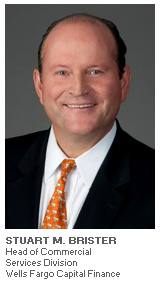
For Stuart Brister, head of the newly established Wells Fargo Commercial Services division, there’s no mystery or magic involved. It’s all about connecting the dots and following the trade flows. Only weeks ago, Wells Fargo Capital Finance announced the formation of its Commercial Services Division with the intention of unifying its many varied factoring and accounts receivable businesses. ABL Advisor spent time with Brister to understand both the impetus and implications of this undertaking. With little in the way of fanfare, he begins by speaking directly to the heart of the matter.
Brister explains, "Until recently, they were really operating two factoring companies. One business was a part of the old Norwest Business Credit operation that was based in Denver. That business focused on several sectors and smaller asset-based transactions. The other business found its origins in the old Century Business Credit, which was based in New York City."

Brister notes that each of these businesses co-existed peaceably for nearly ten years with little overlap. However as both units began to grow and expand into new geographies and product sets, he says the two began to cross paths in time. Brister, who joined the Wells organization in 2005, explains, "Shortly after I came on board here, we began the initial dialogue with regard to laying out a strategic plan that would ultimately join the two groups together. We noticed that with the existence of the two units, we were causing a little bit of our own market confusion both internally at the bank and externally as well."
He notes, the first step was to merge the sales forces. Brister recalls, "We took this on about three years ago. By merging the sales groups, we wound up with greater coverage within certain regions and the situation was almost ideal -- much like the Wachovia/Wells Fargo merger that had come before -- in that the geographies that both groups covered were almost a perfect fit. Secondly, we put both groups under one credit officer in Anthony Montemarano."
From there, Brister says, the verticals fell into place. Under the unified Commercial Services Division, product offerings such as Staffing Services, Government Services, Transportation Services and Purchase Order Finance will be led by Dave Ciccolo as head of the Specialty Group. Kevin Gillespie will head Trade Capital and will oversee the group that handles the retail and consumer goods marketplace. "Our next tact," he says, "was to name one National Underwriting Manager to oversee both businesses from an underwriting standpoint." As the release noted, Marc Grossman was selected to fill that position and industry veteran Darren Linder was appointed to lead the division’s global originations team.
With a solid reporting structure in place, Brister and his team set about having the verticals supported by one technological platform. He says, "When we purchased the GMAC portfolio, one of the driving forces was to acquire the Choice application developed by William Stuckey & Associates. We quickly converted all of Trade Capital and the specialty groups followed last fall."
While systems are systems and people run businesses, the conversion to the same technological platform across all Commercial Services verticals is not insignificant, Brister advises. "We now have a system that was built to respect the nuances and differences that each specialty needs in order to be successful in achieving their goals. At the same time, we are able to apply the best-in-class processes to the back end of the business. We set up redundancy by setting up half of the operation in New York and the other half in Dallas. This way if another Hurricane Sandy hits, we won’t miss a beat … we simply have to switch one location to the other."
Brister notes that this redundancy is also ideal from a marketing and sales standpoint. He states, "I think it’s easy to appreciate the efficiencies that we drove from the technology side along with the best in class practices, policies and procedures. We had this vision five years ago and began the process three years ago. Today, we are driving six verticals behind this technological utility that not only enables us to broaden our product reach, but also allows us to broaden our geography."
Beyond the benefits of having redundant operations and achieving technological efficiencies, Brister sees opportunity to make a significant impact beyond Wells Fargo Capital Finance. He states, "I think by bringing everyone together, this gives us the real opportunity to educate all of our corporate people … the people in commercial and business banking groups that will now have a very clear sense of what we do in Commercial Services and how we can help. Our products are very attractive in a world in which banks are a bit more conservative and letters of credit have been replaced by an open trade marketplace."
He continues, "For us to be able to finance any portion of the supply chain and bring visibility is really what people are looking for these days. We are focused and committed on providing this service, and if it’s not within our group, or even if it is beyond Wells Fargo Capital Finance, we have 85 other product sets within our parent … hopefully we can package a program that gives our customers exactly what they are looking for."
From the customers’ perspective, a unified Commercial Services Division keeps in time with the current realities of doing business. "When manufacturing went offshore, those of us who financed those businesses realized that we needed to figure out creative solutions to financing those businesses … it either meant figuring out a way or shutting down. I think we’ve followed the trade flows in that regard. And the nice thing about the Choice technology is that it offers real time web-based access anywhere in the world. It is multi-currency driven and can be accomplished in a variety of languages and time zones. This opens doors that we historically haven’t been able to open."
For example, as Brister notes, a customer can trace a payment every step of the way once it hits the lockbox. "Once we image a check that comes into a customer’s lockbox, someone sitting in their desk in Iowa can not only see the check came in … they can read the collectors comments, they read the remittance advice that goes with the check and they can see how it was applied. Today, we are providing a back office port … something that at one time was a paper driven process."
With these resources in place – both financial and technological -- Brister assures the phrase "following the trade flows" is meant in the literal sense. “This system can track from the ordering of the goods on the front end to putting the goods into work whether it be in China, Viet Nam or anywhere on the globe. It follows the goods on the water to landing in the U.S. and we are there to provide inventory financing and then receivables financing all the way through the actual cash application once it hits the lock box. This gives you an end-to-end process that we think people have been seeking for a long while.
"And it’s not magical in any form or fashion. It’s just connecting the dots and following the trade flows whether it’s a hard line product sold in the consumer retail vertical or in our government contract business. No matter what, we’re geared to follow the entire flow," Brister explains.
While it’s a bit early to draw any conclusions from the outside, Brister does note he’s received some preliminary feedback from third party providers and other professionals. "They say that they love the simplicity, it is one point of contact and there’s no more confusion. Our sales have been strong and our pipeline is full and I think that’s a good indicator."
Of equal importance is the response and enthusiasm received internally. He says, "From my vantage point, this creates tremendous opportunities for our personnel. People are no longer ‘stuck’ in one vertical … if they want to explore the staffing business or the trucking business or work in the government vertical, those opportunities are available to them. And the more satisfied they are, the greater benefit that is to our clients."
And, he says, the enthusiasm is contagious. "We’ve put together what turns out to be the largest factoring company in the United States and I think everyone likes to be with a major player."
As for Brister, who splits his time between Atlanta and New York as well as points as far off as Hong Kong, Shanghai and Ho Chi Minh City, he’s just as enthusiastic when it comes to the future. "In my 28 years in this business, I’ve never really seen this kind of opportunity. We still have a lot of work to do, but the pieces are lining up very well."